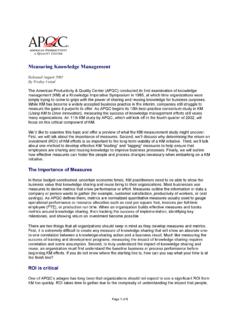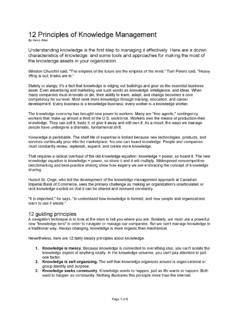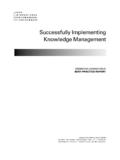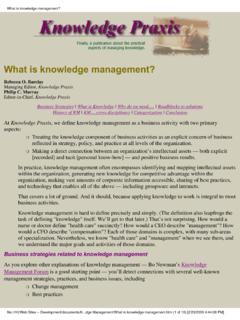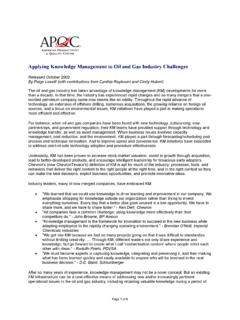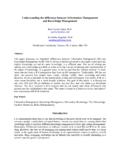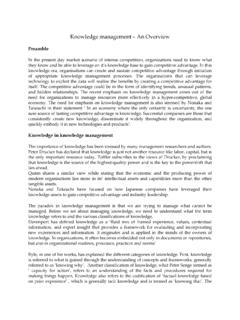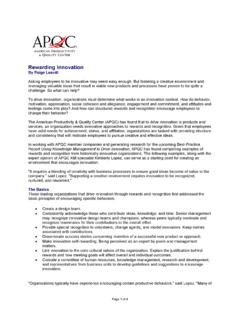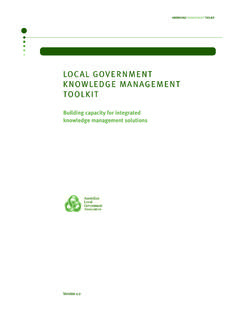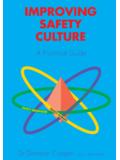Transcription of Knowledge Management and Six Sigma: Exploring …
1 Knowledge Management and Six sigma : Exploring the Potential of Two Powerful Disciplines By Paige Leavitt Both Six sigma and Knowledge Management (KM) share a notable distinction in a corporate universe full of change initiatives and improvement philosophies. Like the embrace of team structures in the 1980s, these two approaches to business Management , after proven successes, have been integrated into regular operations at leading companies, while most methods have been quickly exposed as ineffective trends. And the quality functions that often guide and maintain the learning cultures within organizations are challenged to create a synergistic relationship between the two established approaches. "We have seen every fad come and go," said APQC President Carla O Dell. "We believe that the power of Six sigma and its systematic approach and the power of Knowledge Management are probably not ephemeral and will probably not come and go. What they will do is become part of the fabric of the way we work.
2 And our job is to make sure that the best of both of those comes together." In a recent teleconference with more than 100 participants representing all corners of the marketplace, KM thought leaders at APQC discussed how the principles of Six sigma and KM support each other and create a strong foundation for a learning organization. APQC believes there is a very powerful intersection and synergy between the discipline of Six sigma and the discipline of KM, said O Dell. Comparing Best Practices Six sigma , at the technical/statistical level, is a measure of variation in defects in a system. "If you are operating at a Six sigma level of quality, you have less than defects per million opportunities to make a mistake in your system or your process," said O Dell. "At the systematic or organizational level, when people talk about a Six sigma initiative, they're talking about a broad and comprehensive approach to organizational change driven by data, measurement, projects, and an emphasis on results.
3 " The approach involves a pyramid of Six sigma specialists, called Belts, and two core processes: the Define-Measure-Analyze-Improve-Control (DMAIC) methodology and Design for Six sigma (DFSS) process. As the name denotes, the DMAIC methodology has five steps (Figure 1). At the definition step, a Black Belt identifies a problem and determines its scope. At the measurement step, Belts develop a baseline of how that system, process, or issue is functioning. And at the analysis step, Belts analyze the root causes of the problem. Step four is the improvement process. For those of you in KM, one of the things that Six sigma initiatives have in common is the desire to pilot before you implement, said O Dell. And piloting takes places at the improvement [step]. Then, control is the hand-off from the Black Belt team to the process owner who chartered the project. Page 1 of 8 Figure 1 The DFSS process is used for new products or processes; instead of improving a process, an organization is creating one based on the voice of the customer.
4 Within these processes, some Six sigma best practices are evident: the active involvement of senior Management , a senior executive acting as full-time head of the Six sigma function, a focus on measurement ( , data-driven results), accountability for financial results, rigorous project selection and a project Management methodology, staffing of full-time and part-time Belts, and effective training for future leaders. KM is quite similar in that it is a broad and systemic change process. APQC defines KM as the conscious strategy of putting tacit and explicit Knowledge into action by creating context, an infrastructure, and learning cycles that enable people to find and use the collective Knowledge of the enterprise. Organizations use many of the steps from APQC's Road Map to Knowledge Management Results: Stages of ImplementationTM (Figure 2) in their Six sigma process as well ( , developing key strategies, designing and launching initiatives, and making sure pilots work to expand and institutionalize a process).
5 Figure 2 Page 2 of 8 But the purpose of KM is different than Six sigma . The purpose of KM is to help the right information and Knowledge flow to the right people at the right time so they can make decisions, said O Dell. Some of those decisions are going to be about improving a process, but the objective of KM is not the same as process improvement. KM approaches include self-service, networks and communities of practice (CoPs), and the transfer of best practices. Self-service -- involving content Management , portals, search functions, and expertise locators -- is highly technology-enabled and involves explicit Knowledge . In the self-service arena, KM approaches are about connecting people to information, said O Dell. In Six sigma initiatives, self-service involves project databases and dashboards so that the Black Belts can see what sort of projects have been done and what the results have been. Networks and CoPs are groups of a common interest that share and learn information, trade tools and best practices, and solve business problems.
6 Networks and communities of practice (CoPs) are probably the most vibrant and powerful KM approaches, said O Dell. Some organizations have begun to use them in their Six sigma initiatives, either with communities of their Black Belts or of people who may use the results of those projects. APQC thinks CoPs are not used significantly enough, and that could be one of the problems with the replication of findings from Black Belt projects. The transfer of best practices -- involving facilitated sharing and transfer of Knowledge , as well as internal benchmarking -- is minimally technology-enabled and involves primarily tacit Knowledge . This is from unit to unit inside an organization, said O Dell. If we fix a process in a plant in Iowa, how do we get that used in a plant in the state of Washington? The transfer of best practices. KM best practices include: creating systematic processes that enable Knowledge to flow to the right people at the right time; focusing on core business issues in order to avoid redundant efforts, accelerate the time to competency, make individual Knowledge available to the organization, and cross boundaries and functions; applying robust methodologies; enabling new Knowledge to be created and new problems to be solved; and placing the Management focus on communication, involvement, accountability, and Knowledge -related behavior.
7 A lot of what firms are trying to do when they do KM is save on the cost of not knowing: the duplication, waste, and mistakes of the past, said O Dell. They re trying to shorten their learning cycles, cross silos and boundaries (which is one of the things we think is going to be a value-added to Six sigma ), and apply robust methodologies. And it also focuses on Knowledge creation, which you would expect from Design For Six sigma . An Intersection of Approaches Both KM and Six sigma are quickly infiltrating business Management systems with problem-solving and process-optimization methodologies. Six sigma should not be viewed as a quality program that is commissioned to reduce defects but as a methodology that helps companies better meet the needs of their business. KM shares this goal. We believe that the transfer of best practices, the replication that is supposed to happen in Six sigma in the control phase, could be enabled and huge gains could be made if the tools of KM were applied, said O Dell.
8 CoPs are an intersecting point for Six sigma and KM. By introducing Six sigma findings into a community, newly-stabilized processes can be adjusted as needed. It s going to move out of control if you don t have a community to help sustain it, said O Dell. Page 3 of 8 Compaq (now HP) is one such example. Its warranty team used a Six sigma approach to reduce defects. The result of its efforts over the first year was an $18 million reduction in warranty costs. The company then had difficulty implementing these improvements across functions, so it created a CoP. By implementing lessons learned from Six sigma across the company, Compaq achieved dramatic results. This was the predicament for Ford as well, said Stan Kwiecien. We had established communities of practice, so we built on them to support the transfer of best practices from Six sigma initiatives. That s how it worked. And interestingly, we do not have a community of practice for Six sigma . Not yet, anyway. Halliburton also combined its Six sigma and KM efforts.
9 In an attempt to improve its perforating practices for oil wells, Halliburton created a CoP that uses many Six sigma approaches. To track its progress, the community uses a balanced scorecard with metrics similar to Six sigma . In a short period of time, Halliburton has experienced gains from the community. For instance, the number of hours lost due to root problems dropped from 153 to 50. And Halliburton has a community in place to continue the gains, said O Dell. So, the point of that is there is a lot that KM can learn from Six sigma . And there is a lot that Six sigma can learn from KM. Voice of the customer in the DFSS process is also a potential area for a collaboration of ideas. In Design For Six sigma , Knowledge of the customer-centric requirements is a key input .. to the design process, said O Dell. And if you could use Knowledge Management tools to better understand what the customer is saying to sales people and service people, that information comes back to the folks who can make a difference in the design process.
10 The organizations that succeeded in TQM were those organizations that applied Six sigma to the systemic structures for their process improvement, added NSA s Marianna Overman. And I believe very strongly that Knowledge Management s success will be the same way. Raytheon s Approach to Six sigma and KM Bill Baker, a Knowledge transfer and benchmarking champion at Raytheon, discussed that company s Six sigma process and how it intersects with KM. Its efforts began in 1997, when Dan Burnham of Allied Signal became Raytheon s chairman. Burnham brought his experience with Six sigma to Raytheon and then benchmarked best-practice examples such as GE. The resulting Raytheon Six sigma , or R6s, process improvement strategy applied to the entire company (Figure 3). Involving Lean enterprise tools, the strategy is focused on the customer, tools, and culture through five principles: 1. Specify value in the eyes of the customer. 2. Identify value stream and eliminate waste and variation.
